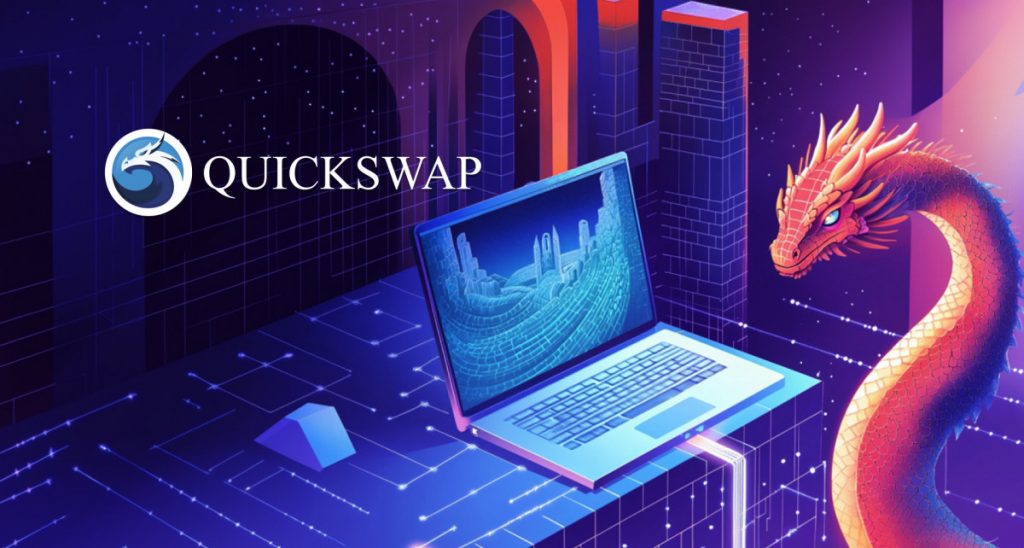Web3 Betting And Predictions Take Center Stage On QuickSwap’s ‘The Aggregated’ Podcast, Drawing Numerous Participants


In Brief
QuickSwap hosted a new episode of its podcast “The Aggregated,” bringing together industry experts to discuss the opportunities, challenges, and dynamics of Web3 prediction markets.

Decentralized exchange QuickSwap, which operates on the Polygon network, has hosted a new edition of its social media podcast series, “The Aggregated,” on platform X. The latest episode focused on the theme of “On-Chain Betting, Gambling, Predictions, and Related Activities on Web3 Platforms” and featured a panel of leading industry speakers.
Participants included Felix, CEO of BetMode, a decentralized blockchain-powered casino platform; $0.02timmy from the Polygon Layer 2 blockchain marketing team; Jaroslav from Cedra, a Layer 1 blockchain; PHILSTA, core team member of Azuro, a prediction layer on Polygon; Lingo, a Web3 rewards ecosystem; jpeg.Flo from PRDT Finance, a decentralized cross-chain prediction market platform; and a representative from Gondor, a company developing a decentralized finance layer for prediction markets.
During the discussion, the participants explored a range of topics, providing insights into emerging trends, challenges, and opportunities within the Web3 betting and prediction space.
The discussion began with the observation that the role of prediction markets depends largely on the context. As one speaker noted, they can serve both as tools for gambling and for forecasting. Some panelists emphasized their forecasting potential, pointing out that one of the advantages of Web3 platforms is transparency: results are verifiable on-chain, payouts are instant, and no intermediaries are required. Others, however, argued that prediction markets often lean more toward gambling—particularly in sports—where participants tend to rely on their knowledge of the games rather than broader forecasting principles.
A number of speakers described prediction markets as functioning more like information markets or alternative news sources. Their effectiveness, they suggested, comes from aggregating hypotheses from many individuals. While they do not represent the general population in the way traditional polls might, they differ from polls in one crucial respect: participants have to stake money on their predictions. This financial commitment creates stronger incentives for accuracy, as participants do not want to lose their capital.
Polls, by contrast, can suffer from self-selection bias, as they only reflect the views of those who choose to respond, and every opinion carries the same weight regardless of expertise or conviction. Prediction markets, on the other hand, allow participants with greater confidence—or potentially insider knowledge—to exert more influence.
Still, some panelists cautioned that prediction markets remain closely tied to gambling, particularly in areas like sports betting. As one speaker noted, the distinction lies in the question being asked: polls typically measure who people want to win, while prediction markets ask who they think will win. Unlike polls, where votes cost nothing, prediction markets require financial stakes, meaning participants tend to enter only when they are confident in their position.
Another question raised during the discussion was whether insider trading should be prohibited in prediction markets. On one hand, access to insider information could undermine fairness; on the other, it might actually improve the accuracy of market forecasts. This sparked debate over whether prediction markets should prioritize fairness or accuracy, particularly in sensitive contexts such as presidential elections or terrorist attacks. In many cases, panelists noted, prediction markets are used less for betting and more for gathering information—suggesting that accuracy may be the higher priority.
Speakers also highlighted concerns around manipulation. With sufficient liquidity and participation, market actors could theoretically influence outcomes, especially if others simply follow large trades. On-chain prediction markets add another layer of complexity: because transactions are transparent, participants can track wallets and observe how large players may be shaping market sentiment.
The panel warned that if prediction markets grow large enough to influence real-world outcomes, they may attract regulatory scrutiny. Governments could begin assessing whether these platforms pose risks to national security or public policy, bringing them under the same legal frameworks that prohibit insider trading and market manipulation in traditional financial systems.
The conversation then shifted to the role of KYC (Know Your Customer) requirements in prediction markets. Some speakers argued that KYC could play a positive role by helping filter out bad actors, reduce manipulation, and create a fairer environment overall. From this perspective, verifying identities would provide greater accountability and make the system more transparent than it is today.
Others, however, voiced concerns that KYC is not the ideal regulatory solution. They noted that it places a lot of power in the hands of regulators and risks undermining the principles of decentralization and user freedom that blockchain technology was built upon. Critics also stressed that KYC can be invasive, eroding privacy and, in some cases, reducing the accuracy of prediction markets. They highlighted the risk of data leaks and pointed out that anonymity can protect individuals from social or professional repercussions if their bets or predictions are unpopular within their community.
According to these speakers, anonymity allows participants to act more honestly and without fear of judgment, ultimately producing more accurate prediction market outcomes.
The conversation also touched on the role of arbitrage in prediction markets, which was generally viewed as a positive force. Arbitrage opportunities encourage participants to correct pricing discrepancies between markets, contributing to more precise forecasts and overall market efficiency. The discussion then shifted to the technical aspects of prediction markets, exploring both the challenges and opportunities involved in their development.
The Twitter Space attracted a lot of attention, with an audience ranging from 300 to 400 listeners, many of whom actively engaged by asking questions and contributing to the conversation.
For those interested in exploring the topic of prediction markets further, the podcast recording is available via the provided link.
‘The Aggregated’ Marks 100 Episodes As Leading Platform For In-Depth Web3 Discussions And Industry Insights
“The Aggregated” is a prominent Web3 podcast that airs every Friday at 3 pm UTC on Twitter. Originally launched in 2023 under the name “All Roads Lead to Polygon,” the show has since evolved, rebranded, and broadened its scope to cover a wide range of Web3 projects and ecosystems, establishing itself as a leading platform for in-depth discussions and innovative debates within the blockchain industry.
The podcast’s varied content ensures it remains central to industry conversations, making it an essential resource for anyone following the development of blockchain and cryptocurrency. Over the past year, it has featured a range of influential guests from sectors including blockchain, finance, technology, politics, and entertainment.
“The Aggregated” invites participants from emerging projects and new ecosystems, as well as established leaders and key influencers, fostering connections and serving as a bridge across the Web3 community. An important factor in the podcast’s success is the interaction between its hosts, Roc Zacharias, co-founder of QuickSwap and Aztec Amaya CSO of at Lunar Digital Assets and the founder of LitVM, whose engaging and complementary styles create an informative yet entertaining experience that resonates with audiences. Their chemistry, combined with the show’s ability to attract high-profile guests, has helped “The Aggregated” stand out in the crowded Web3 podcast landscape.
Recently, the podcast celebrated its 100th episode, marking nearly two years of contributing to the visibility and understanding of decentralized technologies.
Disclaimer
In line with the Trust Project guidelines, please note that the information provided on this page is not intended to be and should not be interpreted as legal, tax, investment, financial, or any other form of advice. It is important to only invest what you can afford to lose and to seek independent financial advice if you have any doubts. For further information, we suggest referring to the terms and conditions as well as the help and support pages provided by the issuer or advertiser. MetaversePost is committed to accurate, unbiased reporting, but market conditions are subject to change without notice.
About The Author
Alisa, a dedicated journalist at the MPost, specializes in cryptocurrency, zero-knowledge proofs, investments, and the expansive realm of Web3. With a keen eye for emerging trends and technologies, she delivers comprehensive coverage to inform and engage readers in the ever-evolving landscape of digital finance.
More articles

Alisa, a dedicated journalist at the MPost, specializes in cryptocurrency, zero-knowledge proofs, investments, and the expansive realm of Web3. With a keen eye for emerging trends and technologies, she delivers comprehensive coverage to inform and engage readers in the ever-evolving landscape of digital finance.


















































